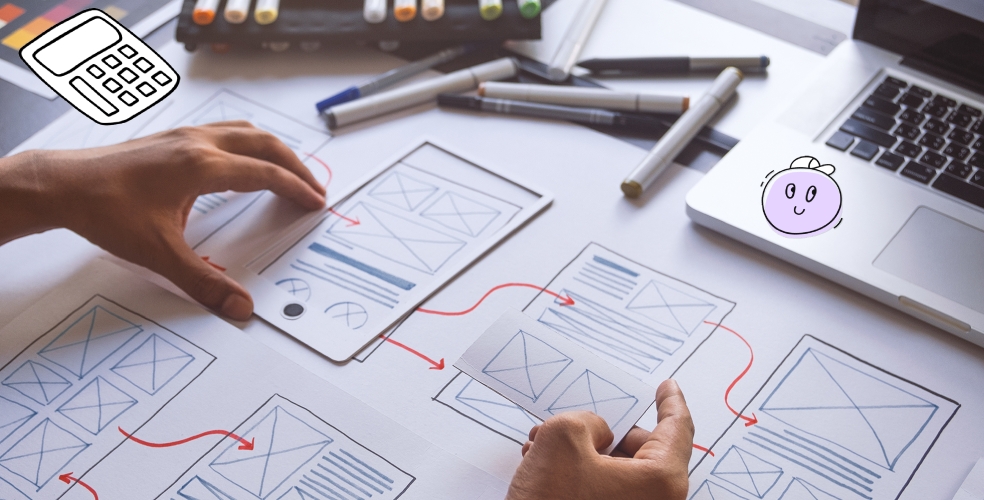A prototype doesn’t need to be perfect, but it must include a way of testing to get feedback from real users.
Prototyping can be used in lots of different contexts: from policy to services, products, ways of working, tools and even technology and software choices. It can be how you test the design of an interface design, but it can just as effectively be used to test parts of a service, a business model, or a process inside an organisation.
You might need to learn about the usability of a product, but the viability of an entirely new service proposition around that product might be a more important question to answer first.
Prototyping as a mindset and way of working
Prototyping can be applied as a mindset and approach for how your entire organisation works and delivers change.
It’s not just about working in code or product development. Prototyping is often seen as a digital capability and way of working ie, building digital things to test. But it can be used for much more than learning about the interactions that happen on a screen.
Types of prototyping
This is the way that we think about different types of prototyping at TPXimpact:
Policy-level prototyping
Testing external/government policy, including ‘theory of change’, controlled tests/trials/pilot schemes.
Prototyping can be used as part of the controlled ‘pilot’ testing of a policy. This will often involve more than one service. When thinking about testing a policy, this is likely to involve pilot schemes or trials in a local area to test an entirely new policy or changes to an existing policy.
Organisation-level prototyping
Testing/evolving team structures and ways of working, including internal/organisation policy: ways of working, software and tools.
Organisation-level prototyping can be used as a ‘test and learn’ approach to setting up new teams and introducing ways of working. This could involve prototyping and evaluating changes across multiple teams at different levels of an organisation.
Prototyping ways of working can be as simple as an internal policy change or introducing new tools to support collaboration.
Service-level prototyping (including prototyping parts of services)
Testing an overall service proposition. Also, it is about gradually testing a full end-to-end service or parts of that service as it scales and becomes operational.
Service-level prototyping is about learning if an entire service or part of a service proposition is viable and how people will interact with key touchpoints across different types of user journeys. Testing entire services in this way can guide teams to develop technical requirements, interactions, and component parts of a service relatively cheaply and iteratively by making sure end-to-end journeys and experiences work in different types of user-led scenarios.
This type of prototyping and testing at a service scale often simulates the interactions of a full end-to-end service experience. It can be evaluated as roleplay or as a full-scale simulation of a real service involving citizens, props, and multiple touchpoints - including online and offline processes and interactions.
The approach we use for service-level prototyping is sometimes called a ‘wizard of oz’ test. This is when the service we’re testing appears to be operated by technology but is actually powered by people, helping us to understand key requirements for technology components of a service before investing further in building them. This approach is covered in more detail in the book Sense & Respond by Jeff Gothelf & Josh Seiden.
An important part of this type of prototyping and testing is doing so in a safe and controlled way for service users. At TPXimpact, we often work on services that have to meet the needs of people in vulnerable and complex situations so we have developed approaches for when failing fast is not an option.
Product-level prototyping
Testing user experience and flows: usability and accessibility of user interfaces. Often focused on digital channels and user interactions.
Product-level prototyping is usually focused on the detail and context of user interactions, thinking specifically about the accessibility and usability of a user interface or flow of interactions.
Prototypes are most commonly used for testing an app, interface, user journey or transaction (transactional or digital components of services). This type of prototyping often starts with simple sketches or by using ‘paper prototypes’. These can then be developed into more detailed digital models — often described as ‘clickable prototypes’ using HTML and/or wireframes and other frameworks.
With modern product development, we often develop prototypes using real data to create a realistic experience and set of scenarios for testing. There are some prototypes that require deep interactivity to the medium that we’re testing for. For example, a dashboard or set of internal processes for an administration interface — prototypes that need to pull through business logic or simulate a level of decision making. This might mean creating a multi-disciplinary team to develop prototypes combining engineering, data and design skills/experience.
Content-level prototyping
Testing words, imagery and messaging to support service and product interactions. Also, to test and develop service/product propositions or models.
Content-level prototyping can be used for designing and evaluating content as part of a product or service. This is a useful guide/technique for how to research and evaluate content.
Prototyping can also be used to test content and communication materials that support a service. This might include learning about a new brand proposition and/or the ways a service needs to be presented and described so that people know and understand what it does or how it’s intended to work.
Testing, learning, and managing risk
However you choose to approach prototyping, it is a way of managing risk. It’s the ability to quickly and cheaply test which ideas and models work when exposed to reality.
The power of prototyping is as a learning tool for scaling new operating models and types of services, as well as usable and accessible products and digital tools.
Most of what we can learn through prototyping is how not to do things or what doesn’t work. This is valuable feedback in gradually increasing the certainty that something will work sustainably at scale as intended. This way, we manage and reduce the risk of building the wrong technology and products (along with the time and costs this incurs). It also means preventing investment in the wrong sets of internal capabilities and ways of working.
Prototyping to show how something works, in reality, can be the tool that will finally show and convince stakeholders, teams, or just about anybody how key assumptions in products and services might be wrong. But then, just as importantly, it creates the opportunity to continuously make improvements through design and learning, whether we’re thinking about policy, organisations, services, products or content.
In part 2, we will explore how to use prototyping at different stages of a design process, starting with discovery (prototyping as a learning tool).

How AI can reinvent the foundations of planning
AI can create a smarter, fairer planning system. Boosting engagement, speeding decisions, and rebuilding trust in local development.
Read moreOur recent insights
Transformation is for everyone. We love sharing our thoughts, approaches, learning and research all gained from the work we do.

How AI can reinvent the foundations of planning
AI can create a smarter, fairer planning system. Boosting engagement, speeding decisions, and rebuilding trust in local development.
Read more
Reimagining new towns: Innovation, digital first delivery and new statecraft
At UKREiiF, we discussed how bold leadership, digital tools, and innovative funding can transform the next generation of new towns into thriving places.
Read more
A rare moment to reset the system, new towns can pioneer digital-first, community-powered, mission-led development.
Read more

